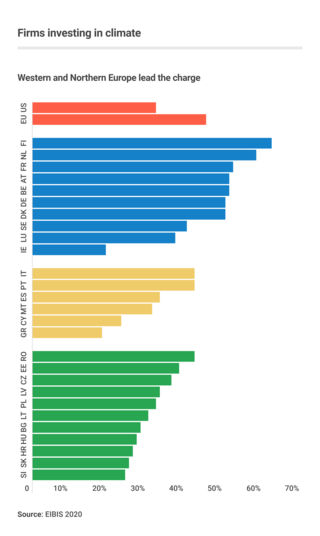
A carbon offset is a reduction or removal of emissions of carbon dioxide or other greenhouse gases made in order to compensate for emissions made elsewhere. A carbon credit or offset credit is a transferrable financial instrument (i.e. a derivative of an underlying commodity) certified by governments or independent certification bodies to represent an emission reduction that can then be bought or sold. Both offsets and credits are measured in tonnes of carbon dioxide-equivalent (CO2e). One carbon offset or credit represents the reduction or removal of one ton of carbon dioxide or its equivalent in other greenhouse gases.

Business action on climate change includes a range of activities relating to climate change, and to influencing political decisions on climate change-related regulation, such as the Kyoto Protocol. Major multinationals have played and to some extent continue to play a significant role in the politics of climate change, especially in the United States, through lobbying of government and funding of climate change deniers. Business also plays a key role in the mitigation of climate change, through decisions to invest in researching and implementing new energy technologies and energy efficiency measures.

Carbon accounting is a framework of methods to measure and track how much greenhouse gas (GHG) an organization emits. It can also be used to track projects or actions to reduce emissions in sectors such as forestry or renewable energy. Corporations, cities and other groups use these techniques to help limit climate change. Organizations will often set an emissions baseline, create targets for reducing emissions, and track progress towards them. The accounting methods enable them to do this in a more consistent and transparent manner.
The Investor Network on Climate Risk (INCR) is a nonprofit organization of investors and financial institutions that promotes better understanding of the financial risks and investment opportunities posed by climate change. INCR is coordinated by Ceres, a coalition of investors and environmental groups working to advance sustainable prosperity.
The 2030 Challenge is an initiative by Edward Mazria and Architecture 2030 to make all new buildings and renovations carbon-neutral by the year 2030 to avoid the catastrophic effects of climate change caused by the building sector. Buildings, construction, and operational activities generate nearly 40% of annual Greenhouse Gas (GHG) emissions, consequently, there is a larger scope to stabilize and reverse emissions in this sector, in order to avoid increased global warming to reach a tipping point. Therefore, instead of seeing it as a trying issue, Architecture 2030, a non-profit organization, strives to beat the woes of climate change by implementing energy-efficient planning and design.

The United States produced 5.2 billion metric tons of carbon dioxide equivalent greenhouse gas (GHG) emissions in 2020, the second largest in the world after greenhouse gas emissions by China and among the countries with the highest greenhouse gas emissions per person. In 2019 China is estimated to have emitted 27% of world GHG, followed by the United States with 11%, then India with 6.6%. In total the United States has emitted a quarter of world GHG, more than any other country. Annual emissions are over 15 tons per person and, amongst the top eight emitters, is the highest country by greenhouse gas emissions per person. However, the IEA estimates that the richest decile in the US emits over 55 tonnes of CO2 per capita each year. Because coal-fired power stations are gradually shutting down, in the 2010s emissions from electricity generation fell to second place behind transportation which is now the largest single source. In 2020, 27% of the GHG emissions of the United States were from transportation, 25% from electricity, 24% from industry, 13% from commercial and residential buildings and 11% from agriculture. In 2021, the electric power sector was the second largest source of U.S. greenhouse gas emissions, accounting for 25% of the U.S. total. These greenhouse gas emissions are contributing to climate change in the United States, as well as worldwide.
Sustainable Silicon Valley (SSV) is a collaboration of businesses, governments, and non-governmental organizations that are identifying and addressing environmental and resource pressures in Silicon Valley. As its first initiative, SSV engaged Valley organizations, who are the SSV Partners, to work towards a goal of reducing regional carbon dioxide (CO2) emissions 20% below 1990 levels by 2010. The SSV approach to reaching this goal is to facilitate strategies to reduce CO2 emissions through increased energy and fuel efficiency and through the use of renewable sources of energy.

Emission trading (ETS) for carbon dioxide (CO2) and other greenhouse gases (GHG) is a form of carbon pricing; also known as cap and trade (CAT) or carbon pricing. It is an approach to limit climate change by creating a market with limited allowances for emissions. This can lower competitiveness of fossil fuels and accelerate investments into low carbon sources of energy such as wind power and photovoltaics. Fossil fuels are the main driver for climate change. They account for 89% of all CO2 emissions and 68% of all GHG emissions.
The Copenhagen Accord is a document which delegates at the 15th session of the Conference of Parties to the United Nations Framework Convention on Climate Change agreed to "take note of" at the final plenary on 18 December 2009.

The Lebanese Center for Energy Conservation (LCEC) is the national energy agency for Lebanon. It is a governmental organization within the Lebanese Ministry of Energy and Water (MEW). LCEC is the technical arm of the Ministry in all subjects related to energy efficiency, renewable energy, and green buildings. LCEC provides energy efficiency and renewable energy programs to the public and private sectors in Lebanon.
Clean Air Cab was an Arizona-based carbon-neutral taxi service provider, and the second taxi fleet in the U.S. to use only hybrid vehicles. Based in Mesa, Arizona, it served the Phoenix area with environmentally friendly transportation service by using clean automotive technology. Clean Air cab ceased operations November 2016.
The California Sustainability Alliance is an organization funded by the California IOUs, to facilitate discussions between various industries on the issues of resource sustainability. The Alliance was set up in 2008 to help California meet its goals in facing Climate change in the State, in relation to energy, resources, and the environment. Efforts are directed at increasing and accelerating sustainable measures and strategies. The Alliance specifically focuses on energy efficiency, climate action, “smart growth” principles, renewable energy development, water-use efficiency, waste management, and transportation management within California.
The, United States Environmental Protection Agency (EPA) began regulating greenhouse gases (GHGs) under the Clean Air Act from mobile and stationary sources of air pollution for the first time on January 2, 2011. Standards for mobile sources have been established pursuant to Section 202 of the CAA, and GHGs from stationary sources are currently controlled under the authority of Part C of Title I of the Act. The basis for regulations was upheld in the United States Court of Appeals for the District of Columbia in June 2012.

"Sustainability," was defined as “development which implies meeting the needs of the present without compromising the ability of future generations to meet their own needs”as defined by the 1983 Brundtland Commission. As sustainability gains support and momentum worldwide, universities across the United States have expanded initiatives towards more sustainable campuses, commitments, academic offerings, and student engagement.
Commuter Challenge is a national, week long event in Canada and is held annually during the Canadian Environment Week. Formatted as a friendly competition between workplaces and Canadian municipalities, the national and host city coordinators announce winners based on the highest percent participation. The event has a strong workplace focus where employers promote the event in-house to support their employees in leaving their cars at home in favour of more sustainable commuter modes including walking, jogging, cycling, in-line skating, public transit, carpooling and remote work.
The C40 Cities Climate Leadership Group’s Climate Positive Development Program (Climate Positive) was launched in May 2009 in partnership with the Clinton Climate Initiative and the U.S. Green Building Council. The program brings together leading district-scale new-build and regeneration projects working to achieve "Climate Positive"—or net carbon negative—outcomes in cities around the world. As part of the C40’s Sustainable Communities Initiative, it aims to create a model for large-scale urban communities and to support projects that serve as urban laboratories for cities seeking to grow in ways that are environmentally sustainable, climate resilient, and economically viable.

The Global Green Growth Institute (GGGI) is an intergovernmental international development organization headquartered in Seoul, South Korea.
South Korea’s Emissions Trading Scheme (KETS) is the second largest in scale after the European Union Emission Trading Scheme and was launched on January 1, 2015. South Korea is the second country in Asia to initiate a nationwide carbon market after Kazakhstan. Complying to the country’s pledge made at the Copenhagen Accord of 2009, the South Korean government aims to reduce its greenhouse gas (GHG) emissions by 30% below its business as usual scenario by 2020. They have officially employed the cap-and-trade system and the operation applies to over 525 companies which are accountable for approximately 68% of the nation’s GHG output. The operation is divided up into three periods. The first and second phases consist of 3 years each, 2015 to 2017 and 2018 to 2020. The final phase will spread out over the next 5 years from 2021 to 2025.

Green economy policies in Canada are policies that contribute to transitioning the Canadian economy to a more environmentally sustainable one. The green economy can be defined as an economy, "that results in improved human well-being and social equity, while significantly reducing environmental risks and ecological scarcities." Aspects of a green economy would include stable growth in income and employment that is driven by private and public investment into policies and actions that reduce carbon emissions, pollution and prevent the loss of biodiversity.
Climate-smart agriculture (CSA) is an integrated approach to managing landscapes to help adapt agricultural methods, livestock and crops to the effects of climate change and, where possible, counteract it by reducing greenhouse gas emissions from agriculture, at the same time taking into account the growing world population to ensure food security. Thus, the emphasis is not simply on carbon farming or sustainable agriculture, but also on increasing agricultural productivity. "CSA ... is in line with FAO’s vision for Sustainable Food and Agriculture and supports FAO’s goal to make agriculture, forestry and fisheries more productive and more sustainable".









